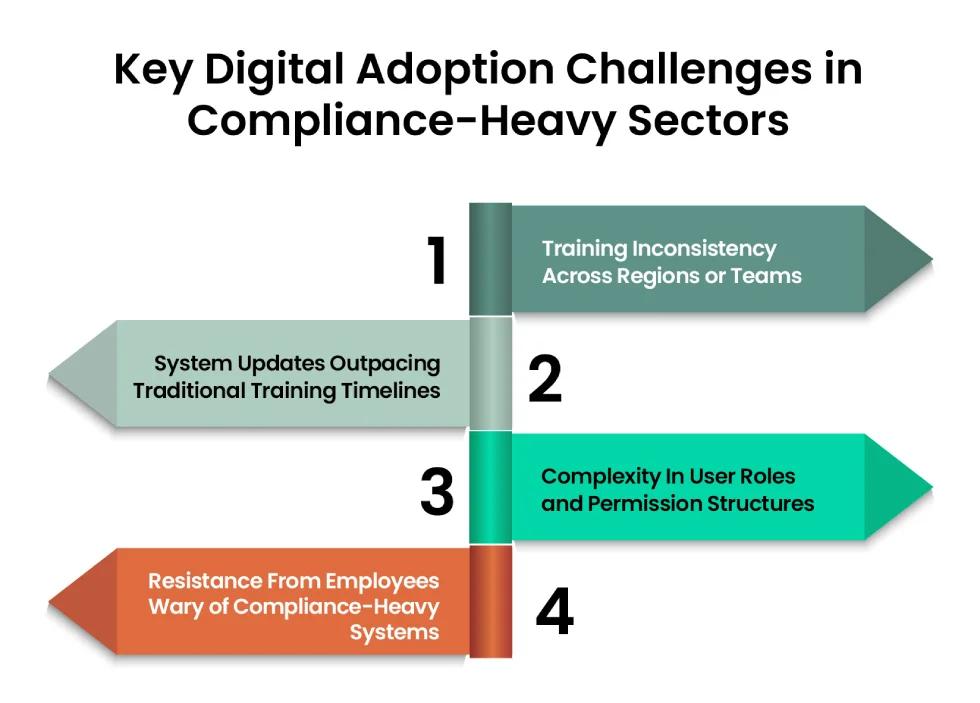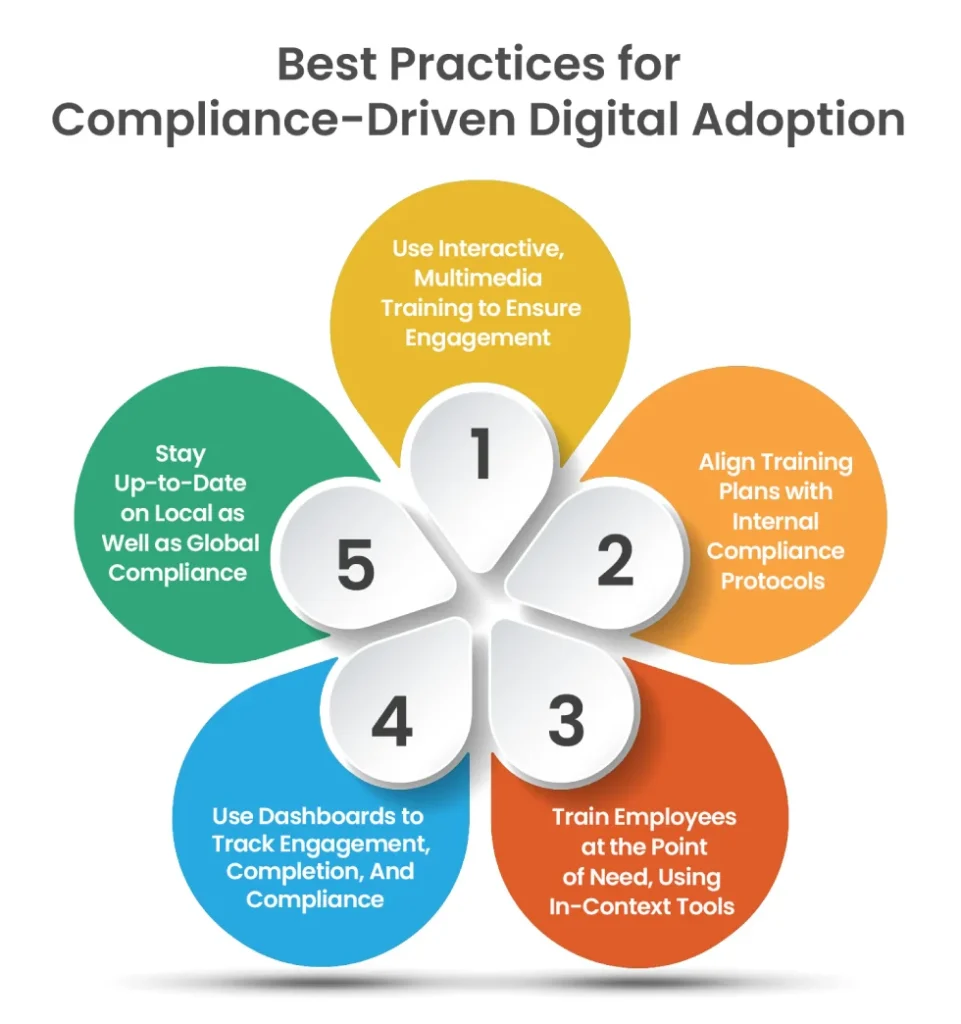Introduction
However, it is for this very reason that digital adoption goes hand in hand with regulatory compliance. One must be completely familiar with how a digital platform works to ensure compliance with required regulations. If you are driving a movement for digital adoption in regulated industries, you must ensure that you provide appropriate compliance and digital training and keep your workforce and yourself up-to-date on revisions and updations to prevent fatal errors. Luckily, if you choose or already use Assima for your software adoption needs, you will be pleased to know that we have your back. Assima is fitted with the right features and functionalities to seamlessly ensure and incorporate compliance training in your company’s digital adoption journey.
Assima takes compliance and security very seriously. Read this to understand how we protect you.
Why Regulated Industries Struggle with Digital Adoption
Let us first talk about what qualifies as a regulated industry. A regulated industry is one that must be governed with greater stringency, including but not limited to a more rigorous legal framework than usual, strong punishment in the event of non-compliance, and greater scrutinization of activities in that industry. The reason is that even the slightest deviation from these rules could pose a serious risk to lives. Some examples include finance, medical services, education, nuclear energy, legal services, government departments, etc.
Besides the obvious damage to public lives and infrastructure, non-compliance also has serious repercussions for your company, like:
- Legal action, fines, and even imprisonment
- Loss of reputation and trust with all stakeholders
- Disruption of business operations at various levels
- Loss of licenses essential for operation
- Damage to the reputation of the business
- Payment of damages to the injured party
- Withdrawal of investment and related losses
- Loss of talent from the workforce and potential recruits
- Impact on market reach and supply chain
- Steep increase in insurance costs
Regulated industries must ensure complete and constant audit-readiness, data accuracy, and strict documentation in all their activities, maintaining a constant environment of compliance. Otherwise, if there are any holes during audits and inspections, your company could be in serious trouble. However, without sufficient and suitable training, your workforce would fall severely short of compliance requirements due to human errors.
This is true for any regulated industry software rollout, be it adoption or migration – regulatory violations during system changes are common due to unfamiliarity with the new system. What you need is stringent training with strict requirements to pass assessments, pre-rollout training to familiarize employees with the new application, in-app support to prevent live system errors, and regular training post-rollout to stay ahead of changes.
Key Digital Adoption Challenges in Compliance-Heavy Sectors
Digital adoption in regulated industries, as we mentioned, can be quite a daunting project to undertake due to the many factors involved in the process. Let us look at some of the hurdles you must overcome:
Training Inconsistency Across Regions or Teams
Often, training for different locations or different departments is handled by different people on disconnected learning systems. This results in major inconsistencies in enterprise training for regulated sectors when it comes to compliance. The mismatch of knowledge shows up in the work done by these employees, causing discrepancies that could potentially spell trouble.
System Updates Outpacing Traditional Training Timelines
Sometimes, the digital solution you are training your workforce in comes with frequent upgrades and patches. With every update, you need to modify your learning materials too. These updates are often released too fast for training updates to keep pace with, creating a chasm between current and expected states of training that keeps growing, affecting the employees’ working ability.
Complexity In User Roles and Permission Structures
If your organization, the software you use, or both have intricately defined user roles, permission structures, and access policies, it compounds the difficulty of regulated industry onboarding. You then must tailor the learning materials according to the requirements of every employee tier in the hierarchy system as well as update them individually for each round of maintenance.
Resistance From Employees Wary of Compliance-Heavy Systems
Employee resistance is quite common even in cases of digital transformation where neither is the industry regulated nor is the digital tool very difficult to learn and use. So, when it comes to onboarding enterprise software like Salesforce or SAP training for compliance-heavy sectors, employees would undoubtedly be far more wary, and often downright unwilling to adopt it.

How Assima Train Supports Secure and Compliant Digital Adoption
With Assima Train, compliance training becomes easier and simpler due to security parameters being built into its technology. Here’s how we ensure complete compliance with regional and company-based regulations at multiple layers:
Cloning Technology for Hands-on Simulation Without Exposing Live Systems
Assima uses a 4X cloning technology to create hyper-realistic simulations for interactive training experiences. It allows for true-to-life, hands-on, scenario-based training that gives employees a thorough understanding of how the software works without exposing live data and operations to them and risking non-compliance.
In-App, Real-time Guidance Ensuring Task Compliance Without Disruption
Assima In-App Search, a subsidiary tool that comes with Assima, provides real-time, in-app informational support to guide users through their operations on the digital solution in a compliant manner. You get step-by-step instructions as well as dynamic search results from the connected knowledgebase to assist you in your work.
Customizable Learning Paths to Reflect Role-Based or Regional Compliance Standards
You can customize learning paths in Assima to ensure that every employee gets the right training based on their roles as well as the compliance policies applicable to the location they work at and the responsibilities they handle. You can design their learning journey based on the access and permission rules governing each team or employee.
Built-in Tracking and Reporting Features to Support Audits and Policy Enforcement
Assima comes with a built-in analytics dashboard that provides you with training statistics based on each user, team, or location. It integrates the data into actionable insights and gives you complete visibility into the state of compliance-guided training. Moreover, it always keeps you audit-ready with reports ready at hand.
Ability to Integrate Corporate-Level Rules and Policies for Additional Security
In most cases, organizations will already have a system in place for digital adoption in regulated industries. You do not have to rewrite the compliance-based rules and regulations for your company into Assima. Assima is built to automatically incorporate these corporate-level policies, security rules, and access permissions into the learning management system.
Best Practices for Digital Adoption Measurement
Let’s look at a few examples of how Assima helps with digital adoption in compliance-driven industries.
Healthcare & Life Sciences: Training on EMR/EHR, Patient Data Handling, HIPAA
The medical industry has some of the strictest regulatory laws for privacy and security. Hence, healthcare digital adoption must be highly compliance-driven at every point. You must ensure streamlined training on EMR/EHR, recommended patient data handling practices, and compliance with HIPAA or the corresponding legal framework at your location. Assima’s simulation training and in-app guidance ensure a seamless transition without disrupting patient care, while data anonymization and compliance-based training ensure PHI privacy. Healthcare compliance training also extends to pharmaceutical industry training, since it deals with patient medical histories as intimately as medical institutions.
Insurance Services: Budgeting, Documentation Standards, Ethics
While the insurance sector partially falls in the financial zone, there are many more factors at play. Depending on what kind of insurance you are availing, additional rules may apply. For example, medical compliance needs to be considered with health, disability, and life insurance, PII for home, auto, and renters’ insurance, and so on. Besides privacy and documentation standards, ethics and budgeting are other sensitive matters that require training support. Assima’s immersive and hands-on scenario-based training, data anonymization, and governance integration allows you to train insurance executives and managers on new applications without any errors or misinterpretations.
Banking & Financial Services: GDPR, Anti-Fraud Training, Process Compliance
Banking and financial services software onboarding also requires strict laws to be followed to ensure that sensitive financial data is not jeopardized. Besides compliance with GDPR or the corresponding law at your location and with procedural frameworks, anti-fraud protection must also be made a part of software training. Assima makes all of this easy through data anonymization, plug-and-play integration with your company’s regulatory policies, built-in Role-Based Authentication Control (RBAC) for fine control of access, and real-time updates about policy changes across training versions at the point of need.
Watch this video to understand how Assima works to streamline digital adoption while ensuring complete security.
Best Practices for Compliance-Driven Digital Adoption
Compliant digital adoption in regulated industries depends not just on choosing the right digital adoption platform but also on adopting the best practices applicable in general as well as for your industry. Some general good practices are:
Use Interactive, Multimedia Training to Ensure Engagement
Compliance training in digital adoption can be tough and boring. There is also the chance of employee resistance. You can overcome these issues by using a variety of training media formats in modular form with interactive, immersive elements.
Align Training Plans with Internal Compliance Protocols
When you build your training program, ensure that the internal compliance protocols of your company get wired into it from the start. That way, your needs would be aligned to your training plan with the least amount of deviation.
Train Employees at the Point of Need, Using In-Context Tools
Do not just provide pre-go live training and let employees take complete charge of the live system. Plug the live application with some kind of tool that provides contextual information as and when needed to prevent any errors.
Use Dashboards to Track Engagement, Completion, And Compliance
Analytics dashboards are a must-have for digital adoption in regulated industries. You need to have 360° visibility into the progress of learners. Track completion and pass rates, errors, drop-offs, etc. to improve training materials and modes.
Stay Up-to-Date on Local as Well as Global Compliance
Always remember that you must consider both local and global compliance requirements in training. Update and maintain your training materials regularly and frequently to prevent training from lagging behind industry standards and laws.

Conclusion
Digital adoption in regulated industries can be scary for both employees and employers, but it is necessary and mandatory. The best recourse is to ensure that your workforce becomes such confident experts in new software that compliance is no longer an afterthought; it becomes a habit. Assima can help you in this endeavor, ensuring that your organization maintains compliance while boosting user adoption.
Our digital adoption experts can help you further in choosing the best solution for your company and industry.
Frequently Asked Questions
Let’s Answer Some of Your Questions.
The extent and stringency of laws in regulated industries are much higher than that of non-regulated ones. With the latest digital technology already being unfamiliar territory, employees are often quite hesitant to use it, fearing serious errors due to ignorance.
Assima Train has built-in RBAC, SSO facilities connected to internal access systems, data anonymization options, and strict data privacy and security rules of its own to ensure compliance is followed to the tee during training.
Assima Train supports both global and local compliance standards. Since it clones applications, any rules and policies built into the system would be automatically followed. You can tweak any part of the content or access rules to better reflect the current needs of your organization.
The regulated industries that Assima Train is best known for serving are healthcare, finance, insurance, energy, and the public sector.
Sandboxes create a completely isolated environment for learners to practice in without interfering with the live system. Simulations simply create life-like copies of an application disconnected from the application itself for the same purpose. In terms of safety, they are on an equal footing. However, in terms of which is more efficient and economical, simulations take the crown. In other words, it is wiser to replace your sandbox environment with a simulation training system.